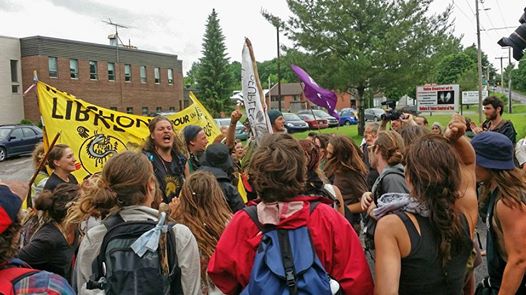Please support our coverage of democratic movements and become a monthly supporter of rabble.ca.
June 13 – 14: Saint Scolastique – Kanehsata:ke
It’s four in the morning in Kanehsata:ke on the 14 of June. The sun is not up yet, but it is coming soon. The Peoples for Mother Earth are waking up early to watch the sun rise with prominent figures from the reserve. It’s still dark, but the marchers are ready for what will be a big day.
Emotions were turned up that morning. The previous afternoon (June 13), the marchers had completed their 700 km walk across the province from Cacouna to Kanehsata:ke — a symbolic and strategic form of resistance to the Tar Sands and the prospective pipelines which will carry them through Quebec. The early part of that day had been spent on a prolonged workshop about potential actions which could follow the march. Many ideas were put forward, and some are currently being worked on.
The march had seen a group of people, most of whom did not know each other beforehand, form friendships which will last beyond the project’s completion. The marchers were at once happy at the march’s successes (including anti-pipeline municipal resolutions passed in at least five towns along the route of Energy East), and sad that the month-long journey was coming to an end. As the group departed Saint Scolastique for Kanehsata:ke, its members were treated to a ceremony by Natasha Kanapé Fontaine, a renowned Inuit poet and activist. The same ceremony had been performed semi-regularly throughout the march. This time though, tears were shed by nearly everyone in attendance.
So as the sun rose early on the morning of June 14, the marchers were full of intense emotions of all kinds. The group stood in the form of a circle — the natural shape of the march’s twice-daily meetings — while a fire burned in the center. Each person was given a handful of spiritual tobacco (“The kind you don’t smoke” according to John Cree, who hosted the ceremony), and, one by one, cast the tobacco into fire while picturing the world which they wanted to see emerge from the present. Each person paused before doing so, as if trying to visualize their own version of utopia.
Afterwards, the marchers returned to the reserve’s school, where they had stayed the night. Later in the morning, a press conference was held to commemorate the ending of the march, and wish luck to a solidarity march which would leave Kanehsata:ke for Ottawa. Speeches were made by Idle No More spokesperson Melissa Mollen Dupuis, environmental justice, indigenous-rights and anti-Tar Sands Cree activist Clayton Thomas-Muller, Coule Pas Chez Nous representative Marie-Josee Beliveau, Jacques Tétreault of Regroupement Vigelence Hydrocarbeurs Québec, march organizer Nicholas Oullet, grand chief of Kanehsata:ke’s band council Serge Simon, and outspoken indigenous rights activist Ellen Gabriel.
The conference was filled with strong calls by all speakers to continue action after the end of the march. Serge Simon opened his speech with a quote: “The Stone Age did not end for a lack of stones, and the age of oil will end long before the world runs out of oil.” This quote, Simon says, can be taken two ways. “You can think that, maybe, we will find a solution in time that will guarantee our survival. Or, if nothing is done, then the opposite might happen.”
Thomas-Muller, after thanking the Mohawk community for their hospitality, pointed out rightly that the fight against pipelines is more than just that. It is a fight against “this new religion that has swept the world over; some call it capitalism, some call it free-market economics. But whatever it is, the problems that we see manifesting, that we do activism to try and address — problems like Tar Sands, cancer, poverty and climate change, violence — all of these things are manifestations of the actual problem. And that is the economic paradigm which we are currently being governed under.”
Ellen Gabriel refers to the tar sands — and, like Thomas-Muller, the economic system which makes it necessary — as “genocide.” The message as a whole was centered on the necessity for continued struggle against the Tar Sands, and for social justice in general. These fights will not be easily won. But — due to the urgency of climate change, the unprecedented social inequality, and the death-by-a-thousand-cuts of democracy in the advanced capitalist world — no other options remain. The only way out is through rebellion.
Once the press conference was finished, the marchers spent the rest of the day together in Kanehsata:ke. A popular Montreal-Colombian group, Gypsy Kumbia, played a show in the parking lot for the marchers. They then travelled to the house of one marcher who lived close by, and had a party which lasted until the sunrise on Sunday. The march had finished with a bang.
While the march itself may be over, the larger struggle against Tar Sands pipelines in Québec is only beginning. I look forward to seeing this fight unfold on the ground. As Nicholas Oullet ended his speech in Kanehsata:ke by saying: “all peoples, united, will never be defeated.” Through beginning the process of uniting settler and indigenous voices in the resistance movement, the Peoples for Mother Earth march hopes to contribute to that process. Nothing less will suffice.




